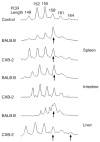Inter-strain tissue-infiltrating T cell responses to minor histocompatibility antigens involved in graft-versus-host disease as determined by Vbeta spectratype analysis
- PMID: 18390717
- PMCID: PMC2613568
- DOI: 10.4049/jimmunol.180.8.5352
Inter-strain tissue-infiltrating T cell responses to minor histocompatibility antigens involved in graft-versus-host disease as determined by Vbeta spectratype analysis
Abstract
Lethal graft-vs-host disease (GVHD) can be induced between MHC-matched murine strains expressing multiple minor histocompatibility Ag differences. In the B6->BALB.B model, both CD4(+) and CD8(+) donor T cells can mediate lethal GVHD, whereas in the B6->CXB-2 model, only CD8(+) T cells are lethal. TCR Vbeta CDR3-size spectratyping was previously used to analyze CD8(+) and CD4(+) T cell responses in lethally irradiated BALB.B and CXB-2 recipients, which showed significant overlap in the reacting repertoires. However, CD4(+) T cells exhibited unique skewing of the Vbeta2 and 11 families in only BALB.B recipients. These Vbeta family reactivities were confirmed by immunohistochemical staining of lingual epithelial infiltrates, and by positive and negative selection Vbeta family transfer experiments for GVHD induction in BALB.B recipients. We have now extended these studies to examine the T cell repertoire responses involved in target tissue damage. Infiltrating B6 host-presensitized CD8(+) and CD4(+) T cells were isolated 8-10 days post-transplant from the spleens, intestines and livers of CXB-2 and BALB.B transplant recipients. For both T cell subsets, the results indicated overlapping tissue skewings between the recipients, also between the tissues sampled within the respective recipients as well as tissue specific responses unique to both the BALB.B and CXB-2 infiltrates. Most notably, the CD4(+) Vbeta 11(+) family was skewed in the intestines of BALB.B but not CXB-2 recipients. Taken together, these data suggest that there are likely to be target tissue-related anti-multiple minor histocompatibility Ag-specific responses in each of the strain recipients, which may also differ from those found in peripheral lymphoid organs.
Conflict of interest statement
Disclosures
The authors have no financial conflict of interest.
Figures


Similar articles
-
Vbeta spectratype analysis reveals heterogeneity of CD4+ T-cell responses to minor histocompatibility antigens involved in graft-versus-host disease: correlations with epithelial tissue infiltrate.Biol Blood Marrow Transplant. 2001;7(1):2-13. doi: 10.1053/bbmt.2001.v7.pm11215694. Biol Blood Marrow Transplant. 2001. PMID: 11215694
-
Specific donor Vbeta-associated CD4 T-cell responses correlate with severe acute graft-versus-host disease directed to multiple minor histocompatibility antigens.Biol Blood Marrow Transplant. 2004 Feb;10(2):91-105. doi: 10.1016/j.bbmt.2003.10.002. Biol Blood Marrow Transplant. 2004. PMID: 14750075
-
Immunodominant CD4+ T cell receptor Vbeta repertoires involved in graft-versus-host disease responses to minor histocompatibility antigens.J Immunol. 1997 Jul 1;159(1):77-85. J Immunol. 1997. PMID: 9200441
-
Biology of graft-vs.-host disease.Am J Pediatr Hematol Oncol. 1993 Feb;15(1):18-27. doi: 10.1097/00043426-199302000-00003. Am J Pediatr Hematol Oncol. 1993. PMID: 8447559 Review.
-
Thymic selection stifles TCR reactivity with the main chain structure of MHC and forces interactions with the peptide side chains.Mol Immunol. 2008 Feb;45(3):599-606. doi: 10.1016/j.molimm.2006.03.025. Mol Immunol. 2008. PMID: 17920446 Free PMC article. Review. No abstract available.
Cited by
-
Donor CD4+ Foxp3+ regulatory T cells are necessary for posttransplantation cyclophosphamide-mediated protection against GVHD in mice.Blood. 2014 Sep 25;124(13):2131-41. doi: 10.1182/blood-2013-10-525873. Epub 2014 Aug 18. Blood. 2014. PMID: 25139358 Free PMC article.
-
Establishment of a murine graft-versus-myeloma model using allogeneic stem cell transplantation.PLoS One. 2014 Nov 21;9(11):e113764. doi: 10.1371/journal.pone.0113764. eCollection 2014. PLoS One. 2014. PMID: 25415267 Free PMC article.
-
Recipient-specific T-cell repertoire reconstitution in the gut following murine hematopoietic cell transplant.Blood Adv. 2020 Sep 8;4(17):4232-4243. doi: 10.1182/bloodadvances.2019000977. Blood Adv. 2020. PMID: 32898248 Free PMC article.
-
Central memory CD8+ T cells induce graft-versus-host disease and mediate graft-versus-leukemia.J Immunol. 2009 May 15;182(10):5938-48. doi: 10.4049/jimmunol.0802212. J Immunol. 2009. PMID: 19414745 Free PMC article.
-
Unraveling graft-versus-host disease and graft-versus-leukemia responses using TCR Vβ spectratype analysis in a murine bone marrow transplantation model.J Immunol. 2013 Jan 1;190(1):447-57. doi: 10.4049/jimmunol.1201641. Epub 2012 Nov 30. J Immunol. 2013. PMID: 23203931 Free PMC article.
References
-
- Slavin S, Morecki S, Weiss L, Or R. Donor lymphocyte infusion: the use of alloreactive and tumor-reactive lymphocytes for immunotherapy of malignant and nonmalignant diseases in conjunction with allogeneic stem cell transplantation. J Hematother Stem Cell Res. 2002;11:265–276. - PubMed
-
- Nash RA, Storb R. Graft-versus-host effect after allogeneic hematopoietic stem cell transplantation: GVHD and GVL. Curr Opin Immunol. 1996;8:674–680. - PubMed
-
- Shlomchik WD. Graft-versus-host disease. Nat Rev Immunol. 2007;7:340–352. - PubMed
-
- Martin PJ, Hansen JA, Torok-Storb B, Moretti L, Press O, Storb R, Thomas ED, Weiden PL, Vitetta ES. Effects of treating marrow with a CD3-specific immunotoxin for prevention of acute graft-versus-host disease. Bone Marrow Transplant. 1988;3:437–444. - PubMed
-
- Patterson AE, Korngold R. Infusion of select leukemia-reactive TCR Vβ+ T cells provides graft-versus-leukemia responses with minimization of graft-versus-host disease following murine hematopoietic stem cell transplantation. Biol Blood Marrow Transplant. 2001;7:187–196. - PubMed
Publication types
MeSH terms
Substances
Grants and funding
LinkOut - more resources
Full Text Sources
Other Literature Sources
Research Materials

